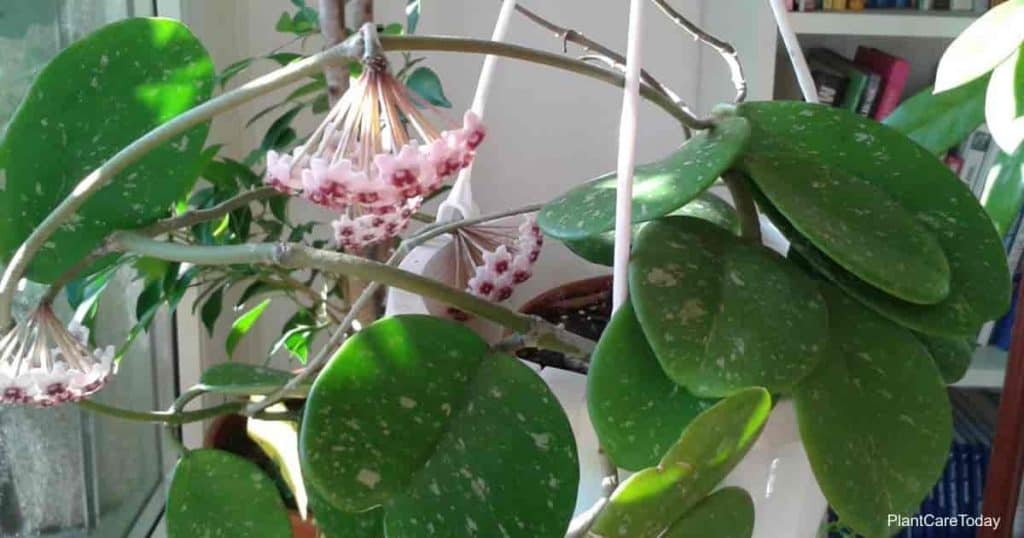Native to Fiji, India, Indonesia, and Thailand, Hoya obovata (HOY-a ob-oh-VAY-tuh) is a striking addition to your Hoya collection.
Hoya obovata has vibrant red and white flowers and rich, sometimes flecked foliage.

The Hoya genus belongs to the Apocynaceae (dogbane) family. The family consists of perennial evergreens with water-retaining properties similar to succulents.
As with other Hoya plants, Hoya obovata shares the nicknames:
- Honey plant
- Porcelain flower
- Wax flower
It is sometimes referred to as sweetheart or heart-leaf hoya due to the way its leaves sometimes invert into a heart shape.
Details on How To Take Care of Hoya Plants
Hoya Obovata Care
Size & Growth
This relatively slow-growing climber has thick, leathery leaves with a waxy finish.
A single plant may have plenty of variations.
- Green leaves being round to oval
- Sometimes leaves are inverted slightly at the tip
- New foliage may be variegated
- Foliage may silver or pink flecks
When grown indoors, this wax plant can grow to 10′ to 12′ feet tall, although it’s often much taller in its natural habitat.
This hoya may also be grown in hanging planters, trailing to 3’ feet or more.
Flowering and Fragrance
Hoya obovata first blooms in its second to third year. The chance of blooming depends on the amount of light the plant receives.
In late spring and into fall clusters of 20 to 25 star-shaped flowers form on a short peduncle.
These blooms consist of fuschia flowers on a background of larger waxy white petals.
Each blossom will last about 2 weeks and future blooms will grow from the spur left behind.
Light Conditions & Temperature
Hoya obovata prefers bright, indirect light but can handle partial shade.
The amount of light affects its chances of blooming, but direct sunlight can burn the leaves.
It grows well in fluorescent lighting.
The obovata Hoya requires good air circulation. Avoid hot or cold drafts.
Hoya plants grow best in USDA hardiness zones 10a to 11, and are not frost tolerant.
Due to its native tropical habitat, obovata plants prefer moderate humidity. They love a spot in your kitchen or bathroom.
Watering and Feeding
Due to the succulent-like qualities be careful to avoid overwatering.
Water thoroughly when the soil is dry 1″ to 2″ inches deep (usually once every 10 to 14 days) and less during winter months.
Obovata needs a fertilizer higher in phosphorus and potassium but lower in nitrogen.
Feed plants every other week during the growing season, stop feeding during winter.
Soil & Transplanting
Use a well-drained soil for your hoya.
Use 2 parts succulent or orchid mix with 1 part perlite or create a soilless potting mix.
Make sure any pot has adequate drainage.
Repot your Hoya every 2 years, ensuring the new soil is dry at the time of planting.
Grooming And Maintenance
Prune your hoya as needed to maintain health or desired length.
Never deadhead hoya flowers, as future blooms will emerge from the same spur.
How To Propagate Hoya Plants
Hoya plants, propagate easily from stem cuttings. Propagate plants and using either water or soil.
- Clip a non-flowering stem containing 2 to 3 nodes and some healthy leaves.
- Dip the end into a rooting hormone or add a few drops to your water.
- To propagate in soil, choose a container with a lid to maintain higher humidity.
- For your potting medium, add one part coconut coir to three parts perlite.
- Insert the cutting and keep the plant at 70° degrees Fahrenheit until the roots begin to form, generally a month or more.
Check out this article on: How To Propagate Hoya
To propagate in water, simply dip the cutting to the first node.
- It will take approximately 2 weeks to begin forming root buds. At that point transfer the plant to soil.
- Keep the potting soil moist for the first week to help your new hoya adapt to the drier conditions.
Obovata Hoya Pests or Diseases
While all hoya plants are fairly resistant to pests, mealybugs, spider mites, Hoya aphids, and whiteflies are still a problem.
Overwatering leads to root rot and fungal infections.
An established Hoya obovata is very drought resistant and salt-tolerant.
The natural latex in the sap may cause an allergic reaction in latex-sensitive individuals.
Question: Are Hoya Plants Toxic?
Suggested Hoya Obovata Uses
As with most hoyas, obovata grows well under fluorescent lighting. They do great in homes, offices, classrooms, and other enclosed spaces.
Grow Hoya obovata plants as a climber on a trellis or potted in hanging baskets.
While you can grow these plants outdoors, it’s best to do so in a container for overwintering indoors.